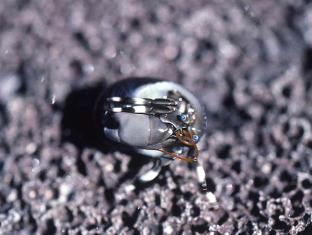Published in the Ocean Watch column, Honolulu Star-Advertiser © Susan Scott
January 31, 2011
 I met friends on the beach last weekend, and as I sat in the sand, Darius, 4 years old, and Naia, 10, came running to show me what they found in the tide pools. In a cup, the kids had several peanut-size hermit crabs living in different kinds of snail shells.
I met friends on the beach last weekend, and as I sat in the sand, Darius, 4 years old, and Naia, 10, came running to show me what they found in the tide pools. In a cup, the kids had several peanut-size hermit crabs living in different kinds of snail shells.
These colorful little crabs are common in Hawaii’s tide pools, and because they’re hardy, colorful and bold, they’re fun to play with. When we picked up the crabs, they ducked inside their little shells, but seconds later, out poked two sky blue eyes on the tips of bright orange stalks. A moment later, the crabs were strolling around our palms on their black-and-white striped legs.
This is safe with Hawaii’s tiny hermits because their pincers are too small to pinch our skin. Some larger species, though, are another story.
The famous coconut crabs of the South Pacific (not found in Hawaii) are hermit crabs that when young inhabit snail shells to protect their soft rears. As adults, though, these 8- to 10-pound crabs don’t need snail shells for protection (nor could they find any large enough to fit).
Hiding is a coconut crab’s first defense, but threaten one and the crab will whirl on you with front claws raised. This is no bluff. Those two enormous claws, which can open green coconuts, can also open (or even remove) human fingers.
The Alaskan king crab is another hermit crab species that carries no snail shell, not even as a juvenile. Like coconut crabs, king crabs fold their soft “tails” (abdomens) under their shelled bodies.
Most hermit crabs, though, back into empty shells large enough to hide inside, but small enough to haul around. The crab coils its narrow rear end inside the shell’s whorl and hangs on with a small pair of back legs. The only time a crab leaves its shell is when it finds one it likes better.
As hermit crabs grow, they need bigger homes, and since empty shells are limited, competition can be fierce. Hermits never kill snails for their shells, but they sometimes try to evict another hermit that has superior housing. An invading crab uses its own shell to knock on the shell it wants. If the invader is the larger of the two crabs, the smaller one gives up and the two exchange shells. If the crabs are about equal size, they fight.
When growing hermits can’t find suitable snail shells, they move into whatever else may be available. One of my young friends’ crabs was living inside a hole in a jagged piece of coral. On Palmyra, where tens of thousands of hermit crabs compete for a limited number of fist-size turban shells, the crabs get creative. I’ve seen crabs there carrying around the end cap of a PVC pipe and another wearing a small glass jar.
Hawaii’s tide pool crabs are usually tiny, their adult bodies only 1/4 to 1/2 inch long. Other species here are larger, inhabiting shells of all sizes, including Triton’s trumpets, 20 or more inches long. Hawaii hosts at least 23 species of hermit crabs near the shoreline and countless others to 1,000 feet deep.
After enjoying their hermit crabs, the children returned them to the tide pools. The next day when I walked past those pools, I collected a few crabs in a cup, hunted for shells for the poorly housed (the hermits moved right in!) and sent them on their way with a feast of chicken scraps.
It’s been a long time since I had fun with hermit crabs. I thank Naia and Darius for reminding me how to play.